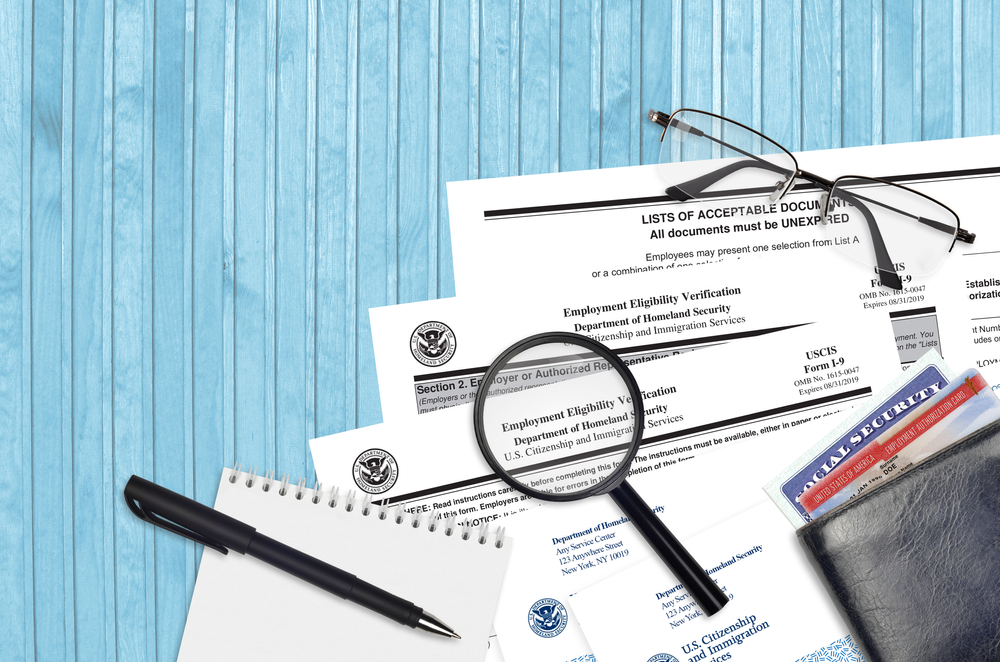New I-9 Form and Regulations Effective November 1, 2023
The United States Citizenship and Immigration Services (USCIS) has released new employment verification regulations and yet another version of Form I-9 which employers must now use, effective as of November 1, 2023. Most employers, particularly those who use E-Verify, will welcome these changes, which reflect USCIS’s attempt to align the I-9 verification process with the modern reality of the virtual workplace.
Technological Accommodations for Employers:
- Remote Document Verification:
- One of the significant advancements in the new I-9 regulations is the ability for employers enrolled in the E-Verify system to verify an employee’s documents remotely. This means that employers can now efficiently verify an employee’s identity and work authorization without requiring the physical presence of the employee. This is a substantial improvement for businesses that may have remote or geographically dispersed employees.
- Mobile-Friendly Form I-9:
- The new I-9 form has been optimized for tablets and mobile devices. This modernization allows employers and employees to complete the form on the go, using the devices they are most comfortable with. This can greatly enhance the flexibility and convenience of the verification process, especially in industries where employees are often on the move or working remotely.
- Improved Accessibility:
- The blog post also highlights that the new form can be downloaded more easily. This improvement in accessibility simplifies the process for employers and employees who may need to access and complete the form multiple times or from various locations. It reduces the potential for errors and streamlines record-keeping.
- Elimination of “N/A” Requirement:
- Another notable change is the elimination of the requirement to enter “N/A” (not applicable) in certain fields of the form. This change reduces the burden on employers, making it simpler to complete the form accurately. It’s particularly helpful when certain sections of the form do not apply to a specific employee, eliminating the need for unnecessary entries and potential confusion.
Impact on Efficiency and Compliance:
These technological accommodations are not only about convenience but also about enhancing efficiency and compliance:
- Remote document verification minimizes the need for in-person meetings, making the hiring and verification process quicker and more adaptable to various working arrangements.
- Mobile-friendly and easily downloadable forms promote accuracy and compliance by ensuring that the form is readily accessible to those who need it, when they need it.
- Eliminating the “N/A” requirement reduces the risk of errors and ensures that the form is completed more accurately, contributing to better compliance with immigration regulations.
Changes to the Form I-9 Itself:
- Shortened Form:
- The new Form I-9 has been condensed, with sections 1 and 2 now fitting on a single page. This reduction in length streamlines the form, making it more concise and easier to navigate for both employers and employees.
- Separate Reverification and Rehire Supplement:
- The inclusion of a separate, standalone supplement (Supplement B) for reverification and rehire situations enhances clarity and organization. Employers can use this supplement when necessary, simplifying the process for these specific circumstances. The ability to attach additional supplement sheets as needed ensures flexibility.
- Terminology Updates:
- USCIS has updated the terminology used in the form. The replacement of “alien authorized to work” with “noncitizen authorized to work” reflects more inclusive language and aims to reduce any potential confusion regarding an employee’s work authorization status. The clarification of “noncitizen national” and “noncitizen authorized to work” helps ensure accurate completion of the form.
- Anti-Discrimination Emphasis:
- The form now provides a revised explanation on how to avoid discrimination during the completion of Form I-9. This emphasizes the importance of fair and non-discriminatory practices during the verification process, promoting compliance with anti-discrimination laws.
- Revised Lists of Acceptable Documents:
- USCIS has updated the Lists of Acceptable Documents page to include some acceptable receipts. Additionally, a checkbox has been added for eligible employers to indicate if the employee’s Form I-9 documentation was examined under a DHS-authorized alternative procedure rather than through physical examination. These changes reflect the evolving landscape of acceptable documents and verification methods.
Incorporating these updates into the Form I-9 and associated processes aligns with the goal of simplifying, modernizing, and improving the employment eligibility verification process while promoting compliance with immigration regulations. These changes are designed to benefit both employers and employees by making the process more efficient, user-friendly, and legally sound.
Form I-9 Instructions:
- Simplified Instructions:
- One of the key improvements in the new Form I-9 is the simplification of the instructions for completing the form. The goal is to make the process more straightforward and understandable for both employees and employers. Simplified instructions reduce the likelihood of errors and misunderstandings, promoting greater compliance with immigration regulations.
- Reduced Page Count:
- The blog post mentions that the instructions have been condensed from 15 pages to just 8 pages. This reduction in the length of the instructions reflects a commitment to clarity and efficiency. Shorter instructions are more concise and easier to navigate, making it less daunting for individuals tasked with completing the form.
- Streamlined Steps for Employers and Employees:
- The new instructions streamline the steps that both employers and employees need to follow when completing Form I-9. This streamlining not only simplifies the process but also ensures that each party knows exactly what is expected of them. Clear and concise instructions help minimize errors and omissions, which can lead to compliance issues.
- Explanation for Using the New Checkbox:
- The inclusion of an explanation for using the new checkbox is a valuable addition to the instructions. This checkbox is intended for employers who choose to examine Form I-9 documentation under an alternative procedure authorized by the Department of Homeland Security (DHS). The explanation ensures that employers understand how to correctly utilize this feature, promoting compliance with DHS guidelines.
Benefits of Simplified Instructions:
- Reduced Confusion: Simplified instructions reduce confusion for both employers and employees. When individuals understand what is required of them, they are more likely to complete the form accurately and in compliance with immigration laws.
- Time and Cost Savings: Shorter and more straightforward instructions can save time and reduce the administrative burden on employers. This can be especially valuable for businesses with high employee turnover or those that hire a large number of employees.
- Enhanced Compliance: By providing clear, concise, and easy-to-follow instructions, the new Form I-9 instructions enhance overall compliance. Fewer errors and omissions mean a reduced risk of penalties and legal issues related to improper completion of the form.
- Accessibility: The simplified instructions make it easier for employees and employers to access and understand the guidance provided, regardless of their level of familiarity with immigration regulations.
I-9 Reimagined: A More Accessible and Efficient Era
In summary, the comprehensive revisions to the Form I-9 and the accompanying simplified completion instructions represent a significant step forward in the realm of employment eligibility verification. These updates reflect a commitment to modernizing the process, increasing accessibility, and reducing the administrative burden on both employers and employees. By streamlining the form, enhancing technological accommodations, and emphasizing clarity, these changes not only improve efficiency but also contribute to greater compliance with immigration regulations. Employers can now navigate the I-9 process more seamlessly, reducing the risk of errors and penalties, while employees can complete the form with greater ease. These changes mark a positive evolution in the ever-changing landscape of employment verification, aligning the process more closely with the needs of today’s diverse and mobile workforce.








